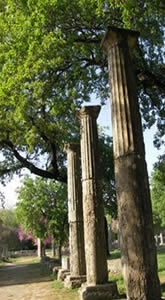Ancient olympia history

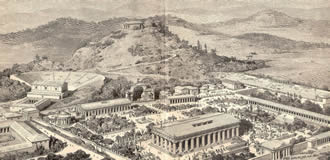
Gods and Monsters
Zeus The pantheon supreme god ruled the skies and fathered hundreds of heroes with his supernatural libido.
Poseidon The god of the sea was Zeus brother and some time his greatest rival.
Athena Zeus daughter was a virgin warrior goddess of wisdom and philosophy. she was also goddess of weaving and patron of athens
Apollo The handsome god and poerty presided over the muses
Artemis Apollo's twin sister of the moon and the hunt and remained a virgin
Aphrodite Voluptuous Aphrodite was Artemis polar opposite the temperamental goddess of love has dozens of affairs
Minotaur Crete's queen pasiphae conceived this bull headed human bodied monster with a bul sen by poseidon
Cyclops The most of famous of these one eyed giands in polyphemus the monster whom Odysseus blinded in the odyssey
Sirens The beautyful sirens with their bewitching songs nearly lured odysseus sailors to their deaths on the rocky shore
Medussa The gaze of this snake headed gorgon turned men to stone. Perseus deafeated her only with the help of athenas gleaming shield in which he could safety see his foe.
Theseus king The son of Athens king Aegeus was secretly raised far from court.At 16 armed with a sword left by his father, Theseus left from athens en route slaying dozens of monsters terrorizing Attica.He became athens greatest king and hero.
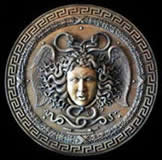
3000 BC
The fertile region of olympia was first settled during the 3rd millenium BC.It was then that the earliest structures were built at the southern foot of the hill of cronus.They were built of uncut stone and had one apsidal wall. The pottery shards found here establish tha these buildings served as residences. The side does not appear to have yet been used for cult activity.
1400 BC
The iavish Mycenean discovered at the site of the new museum have led scholars to believe that an important Mycenean city still lies buried near olympia. This may be Pisa the city ruled by the legendary king Oenomaus. This entire section of the western Peloponnese, know in antiquity as pisatis was densely populated Mycenaenan sites that have been found within a large radius of olympia. Despite this archeologists have yet to un earth ancient pisa the most important city of the region.
1100 BC
The destruction of the Mycenean palaces and the sub sequent decline of Mycenean civilization were accompanied by the appearance of new tribes on greek territory. Legend has it that the region of olympia was settled by the Aetolians founded elis the ancient city state that for many years contended with the older pisa for domination over the olympia sanctuary. The first evidence of cult activity in the altis dates from around
900 BC
By the 9th century BC olympia was already a popular sanctuary as evidenced by the many bronze votive offerings that were brought by pilgrims from all over Greece and left at the site. The temenos or sacred precinct still must have consisted of a simple wall enclosing the sacred grove and the initial altars. The faithful hung their offerings from trees or laid them at the altar. The sanctuary attracted pilgrims based on the reputation of the polemic god zeus and the oracle of olympia which specialized in military matters. Emmisaries came from all parts of Greece to ask for counselor for the god s blessing in battle.
776 BC
is said to be the year of the fist olympic games. Regard less of whether or not this information can be corroborated by what we know today. The legend of the sacred truce concluded by the three kings Iphitus of Elis, Lycourgos of Sparta and Cleostenes of Pisa is very appealing. In force for all participating Greek city states the sacred truce ensured the cessation of hostilities amongst them and a suspension of executions for the duration of the games.The olympic games gradually became panhellinic in scope and the sanctuary evolved into an important center. From the lists of the olympic victors we know that athletes came from many Greek city states as far away as magna greecia.southern italy, Sisily, the black sea , and the northern Africa. The great festival of the god Zeus seems to have provided Greeks from distant colonies with the opportunity to maintain close contract with their homeland.
680 BC
Virtually the entire altis was transformed during the early 7th century BC. The area south of the hill of cronus was leveled and reconfigured using the sacrificial ashes from the altars and many of the older votive offerings. The end of the 7th through the early 6th century BC marked the start of a period of intensified construction the continued almost without a break until the end of antiquity. By 668 BC the control of the century had already passed into the hands of the Pisatans.
The Hereum the first temple in the altis was build around 600 BC with funding from the inhabitants of scillus allies of the pisatans in Triphylia. The importance that olympia acquired as a panhellinic sanctuary is reflected in the care with with the Greek city states build their treasuries. These miniature temple like structures housed the city states offerings to olympian Zeus and testified to their political power. The custom whereby olympic victors offered statues of thanks to the sanctuary also began at this time
572 BC
The inhabitants of Elis with the help of the Spartans managed to subjugate the Pisatans and regain control of olympia. They maintained this positions until the end of antiquity
490 BC
Olympia reached its pinnacle in the 5th century BC. The allied forces of the Greek city states successfully repelled the Persians invaders. Greeks were empowered with a new sense of unity and the panhellinc sanctuaries were endowedwith new prestige. at the 476 BC Olympiad the assembled crowds acclaimed Themistocles as the liberator of Greece.
There are indications that democracy was established in Elis in the early 5th century and that this change was associated with certain physical alterations in the sanctuary and in the organizational structure of the games. In 472 BC two days were added to the olympic games increasing the period to five days. Two years later construction commenced on the enormous temple of Zeus and the other monumental buildings in the altis
430 BC
The temple of Zeus was complete in 456 BC. Two decades later the gold and ivory statue of Zeus. a work by the famous ancient sculptor Phidias was erected in the cela. The statue was 12.4 metter tall and was one of the seven wonders of the world
364 BC
An unprecedented event occurred during the 104th olympiad. A battle broke out in the sacred precinct between the Eleans and Arcadians. The Arcadiants had taken over the sanctuary and were helping their allies the Pisatans to organize their own olympic games. The Eleans managed to regain control of the sanctuary but lost some other portions of their domain.
338 BC
After the battle of Chareonea Philip II of Macedonia began erecting the building know as the Philippaeum during Hellinistic times the sacred grove underwent further reconfigurations. The stadium which in the 4th century BC had been moved outside the altis was mow separated from it by the long narrow Echo Colonnade. The olympic sanctuary also attracted the wealthy sovereigns of the hellenistic era who embellished it with elaborate offerings. There were also hoards of pilgrims arriving from major hellenistic centers including the Greek cities of Egypt and Asia Minor.
146 BC
The Roman conquest of Greece did not affected the holding of the olympic games or the functioning of the sanctuary in fact after his 146 BC victory against the Achaean league in corinth the Roman general Lucius Mummius gave the 21 shields he took as war booty in an offering of thanks to the sanctuary of Olympia. This was in keeping with the Greek custom of dedicating war plunder of olympian Zeus.
85 BC
While the Romans factions were at war with one another the politician Sulla sacked the sanctuary. And in 80 BC the olympic games were held in Rome.
31 BC
The pax romana and the period of the roman empire marked the beginning of new greatness for olympia. Roman emperors were benefactors of the sanctuary and embellished it with new buildings. Most of the auxillary structures in the sanctuary such as hostels and baths were either constructed or expanded during the period of the roman empire. The cult of the roman emperors was introduced in the metroum the temple of meter mother of the gods. Emperor Nero himself visited olympia in 67 BC and that year the olympic games were postponed for two years so that he could compete in theme before returning to Rome. During these late years olympia not only served as a religious center but also attracted visitors with scholarly interests in ancient history. One of these scholars was the traveler pausanias who visited olympia between 160 and 173 AD. Since the old customs were no longer alive there were special guides or exigites at olympia th show visitors around the monuments and explain the legents.
267 AD
During the turbulent years when the heruli invaded Greece a fortification wall was hastily erected to protect the gold and ivory the statue of Zeus from the invaders. Many of the sanctuary buildings were dismantled at that time so that their architectural ements could be used in the construction of this wall.
300 AD
A powerful earthquake caused extensive damage to already beleguered buildings at Olympia.
330 AD
Constantine the great removed the gold and ivory statue of Zeus to Constantinople where it was later destroyed in a fire.
393 AD
The olympic games were held for the last time in 393 AD. That year the emperor Theodosius issued a ban on all pagan cults and sanctuary activity. The early Christians subsequently destroyed many of the buildings in the altis. A small Christian cummunity settled on the site building their homes on top of the ruins of the sanctuary. Phidias workshop was converted into a christian basilica. The site was completely abandoned following the two catastrophic earthquakes of 522 and 551.
600 AD
A community of slavs that settled here in the 6th century was the last to inhabit Olympia. After the 7th century the area was abandoned and gradually became submerged under the silt of the Alpheus and Cladeus rivers.
1776 AD
There was nothing left to testify to olympias former opulence when the english archeologist Richard Chandler came here in 1766 and discovered that this indeed was the site of the acclaimed sanctuary. Later a French expedition arrived in olympia during the Greek war of independence against the Turks 1821-29. The french team conducted a small exploratory excavation that brought to light the first relics of the temple of Zeus. Major excavations began in 1875 under the directions of the German archeological institute.
1896 AD
The Philhellene and visionary Baron Pierre de Coubertin made a proposal that resulted in the formation of the international committee and the revival of the olympic games. That same year the first games were held in Greece as tribute to the birthplace of the olympic movement.
>>
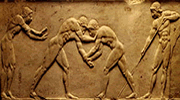
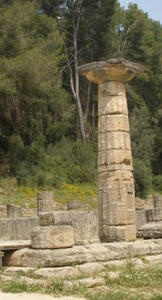
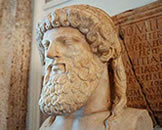
The Pan-Hellinic idea
The political organization of the Greek peoples into city states fostered competition amongst them. Despite many commonalties (common, language, common religion, etc.) the Greeks felt a sense or unity only against the barbarians.
Although the 5th century BC began with the joint action of the Greek cities against the Persian foe, in the end it wasmarked by one of the greatest civil wars. The consept of the Greeks as a unifiednatio took shape mutch later in th 4th century BC when the institution of the city state was alredy showing its first sign of crisis.
The Pan-Hellinic sanctuaries and athletic competitions functioned to promote the idea of unity among the Greek cities. The olympic sanctuary and the games in particular which open only the Greek athletes was an ideal forum for 4th century BC thinkers and orators (such Gorgias, Lysias and Isokrates) who were alredy espousing the political unification of all Greeks to present this idea to a large audiense. This Olympia became the birthplace of the Pan-Hellinic Idea.
